Book review: Rauchzeichen: Meissener Porzellanpfeifen zwischen Tabakdunst und Pfeifenkunst, Keramos, 2021.
Auteur:
Don Duco
Original Title:
Boekbespreking: Rauchzeichen: Meissener Porzellanpfeifen zwischen Tabakdunst und Pfeifenkunst, Keramos, 2021.
Année de publication:
2021
Éditeur:
Amsterdam Pipe Museum (Stichting Pijpenkabinet)
Description :
Discussion of Walter Morgenroth's monograph on eighteenth century porcelain pipes with the Meissen factory in the center.
As a double issue of the professional journal Keramos issued in Germany, an extremely interesting monograph on the porcelain tobacco pipe was published this month. The author is Walter Morgenroth, an expert on the porcelain pipe par excellence. As early as 1989 he published a monograph on this subject under the title Tabakpfeifen Sammeln, Kunstwerke in Porzellan, which was already ground-breaking at the time (note 1). With 240 pages the new book is more bulky than the old one (fig. 1). In addition, it is richly illustrated with beautiful clear full color photos. The publication appeared in the specialized journal of the German Gesellschaft der Keramikfreunde (Society for the Friends of Ceramics). Since 1958, this circle has been stimulating scientific, historical or artistic based studies of ceramics. Their two annual editions are characterized by extremely thorough (Gründliche) articles. The new book is representative of that approach. It is divided into five chronological chapters and focuses on the pipe production at the Könichlichen Sächsischen Porzellan-Manufaktur in Meissen with an emphasis on the eighteenth century.
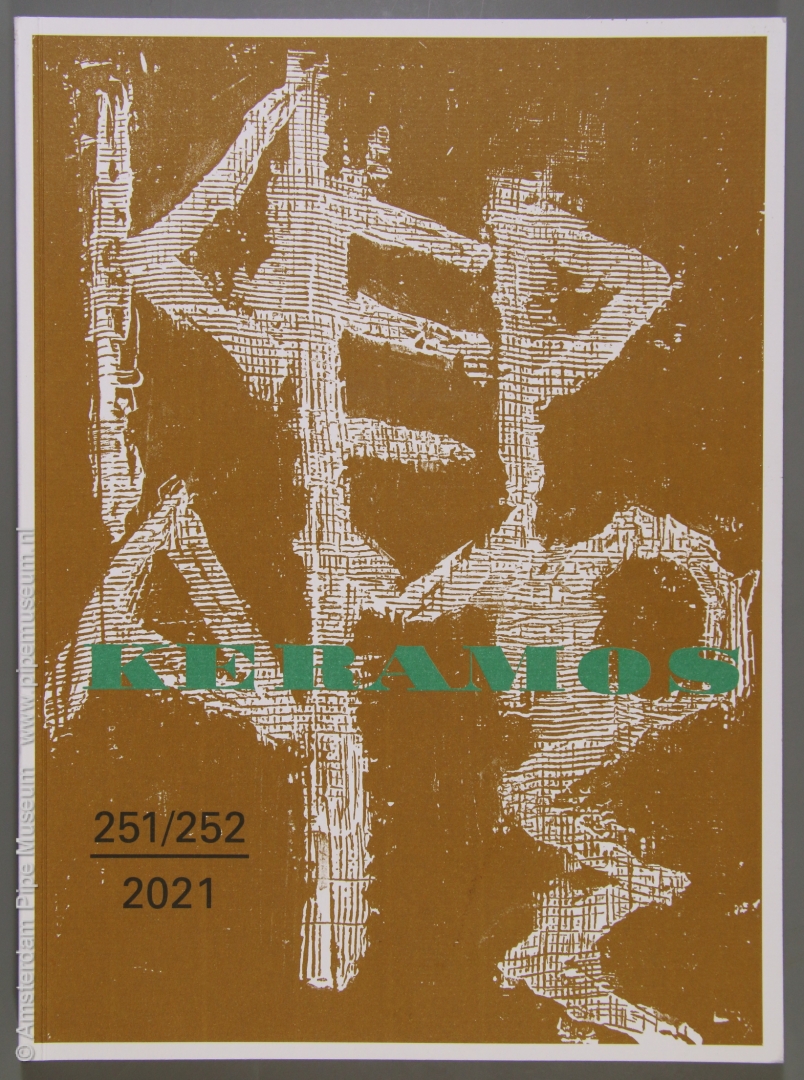
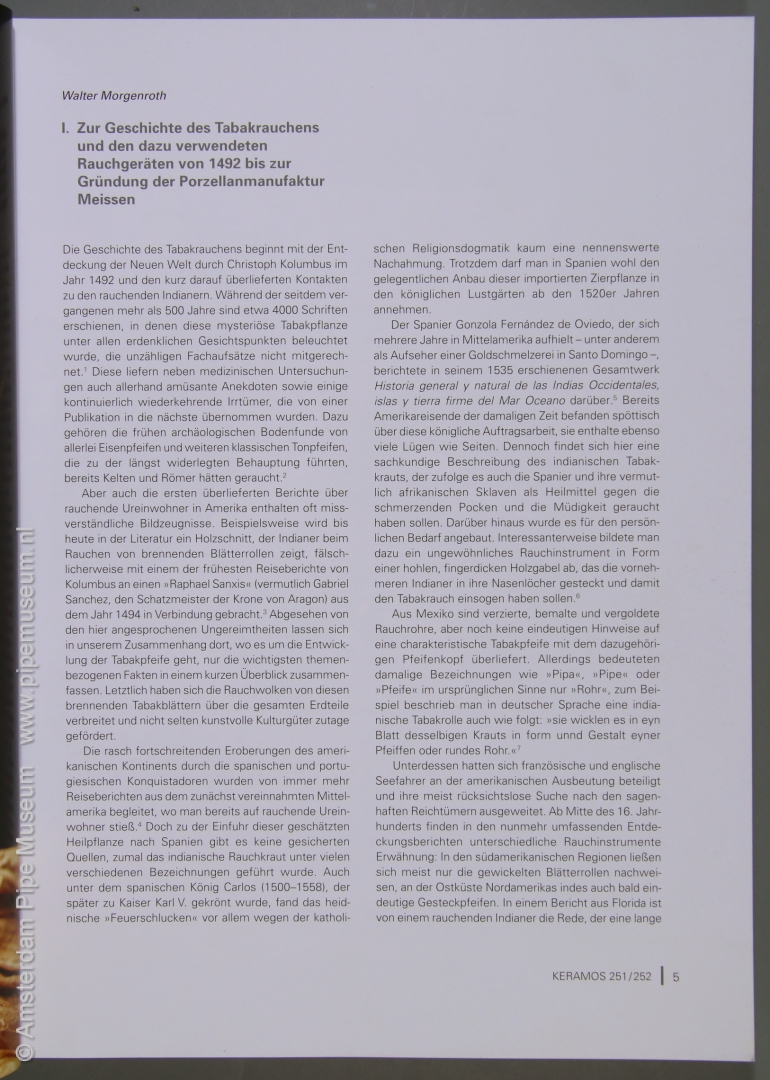
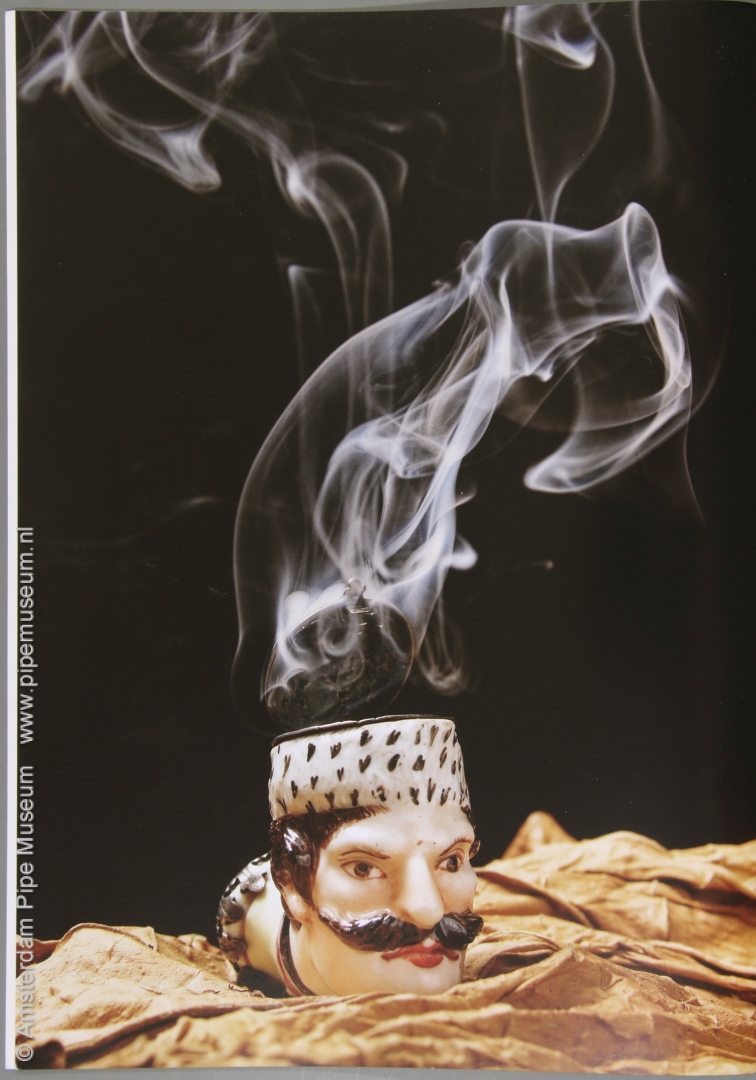
Chapter I (p. 5 - 20) introduces the history of smoking from the discovery of America to the introduction of the porcelain tobacco pipe at the beginning of the eighteenth century. That story is actually separate from the theme of the publication, but it is special because of the approach. Morgenroth did not blindly copy the existing historical surveys, but studied the original printed sources, paying particular attention to the references to the smoking utensils in use at the time. The author cites known and unknown titles, quoting what contemporary authors observed at the time and adding his own opinion about it (fig. 2). As a matter of fact, the structure of this introduction does not differ much from the 1989 edition, although numerous observations have been more accurately or better elaborated.
Chapter II (p. 21 - 32) deals with the start of the porcelain factory at the Albrechtsburg in Meissen under the patronage of Friedrich August II, Elector of Saxony. In that first period, inventor Johann Friedrich Böttger (1682-1719) developed the forerunner of porcelain. For Europe, its invention started in 1710 with experiments that eventually led to a proto porcelain, initially with a reddish-brown shard commonly known as Böttger stoneware. Morgenroth proves that the tobacco pipe was an article of some importance from the very beginning. A separate factory was even founded in 1711 for Böttger pipes after Gouda design (12). That company soon proved unprofitable, as the pipe stems warped due to the high temperature in the kiln. Alternatively, the stub stemmed pipe is designed after Turkish fashion (10, fig. 3). Yet we read that in 1719 no fewer than 7,650 pipes are in stock, which means that a considerable pipe production is undeniable. The story of Böttger's struggle to perfect porcelain and the solitary confinement he had to endure, reads like an exciting story. Ultimately the outcome is positive, although it took some time before the porcelain shard transformed from yellowish to perfectly white. Böttger himself did not survive that last phase, around 1724.
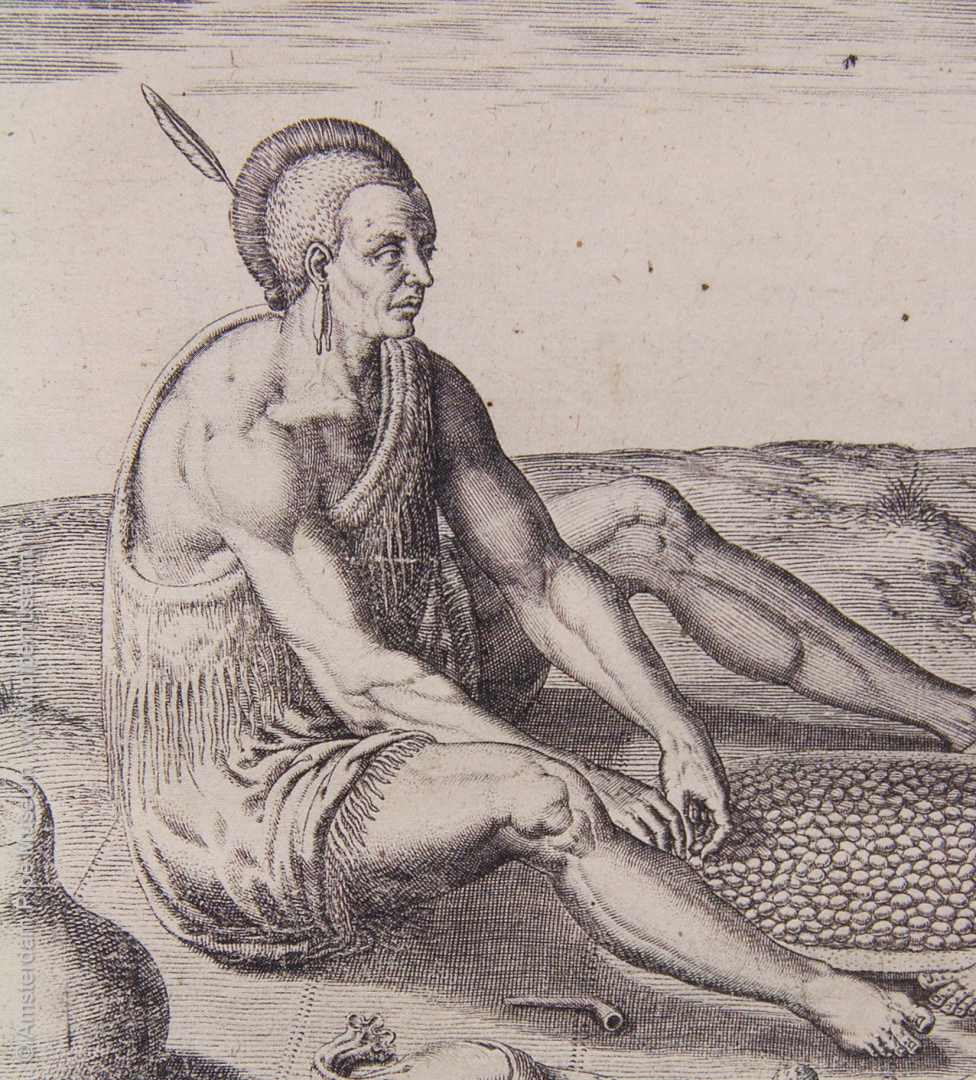
Chapter III (p. 33 - 86) pays attention to the development of the painted porcelain pipe bowl under the direction of Johann Gregorius Höroldt (1696-1775). From 1723 onwards he has his own studio where he spend his life diversifying the colour palette and devising painting decors. The style is initially strongly related to that of Oriental porcelain. It shows favourite decors for the European taste. In the earliest period, the Könichlichen Sächsischen Porzellan-Manufaktur already distinguishes four qualities of porcelain, each with the painting becoming more extensive when the quality of the piece is higher. The earliest pipe bowls, from the 1720s and 1730s, show Indian flowers (Indische or Indianische Blumen), which are sprinkled over the bowl with the accent on the front (16-19). The palette was initially limited as not all colours could be used yet due to the burning temperature. The gold paint finish is mentioned as a specialty. The floral decor is succeeded by Japanese Figures (Japanische Figuren) or Chinoiseries (20, 21, 26).
The beutelförmige or bag-shaped pipe bowl predominates in that period, always mounted with a hinged cover and stem holder made of silver or gilded brass. In the 1740s, people speak of the façonpfeife, a fashionable luxury pipe that is suitable for smoking in domestic circles. The painted landscape with a lot of gold is the most expensive type. A trademark is not yet applied in that period, there was no competition yet. In chronological order, the publication presents beautiful, prestigious products that testify to an increasing love for decoration (fig. 4). In addition, an expansion of the shape variety is taking place, in particular with Ulmformen (31, 47-49, 51, etc.) and the original Leuchter Tyllen (62-66).
Chapter IV (p. 87 - 161) is the longest and deals with the figural porcelain pipe under the direction of Johann Joachim Kändler (1706-1775). This craftsman was appointed as a modeller in 1731. In contrast to the decorator Höroldt, Kändler is primarily a designer, perhaps better described as a sculptor. His original imagination and great skill in modelling created a new pinnacle in the factory history.
The main theme in this section is the portrait pipe, the first example of which (67) predates Kändler's appointment. This type of pipe is followed by heads of men and women, including characters such as Judengesicht (70-72), Husarenkopf (75) or more specifically the court jesters Frölich (84) and Schmiedl (85). The second design merits include figural creations with an even more outspoken design such as a lion with a rococo shield (74), sitting bears (87-88, 125) or reclining dogs (89, 98, 99, 124). Rather artificial but extremely interesting is a bag-shaped pipe bowl with a few animal heads (76), a hunting representation (81) or a pipe with four faces (93). From 1770 the human head with turban dominated in countless variants, mostly women but also some men. Just because of the popularity of the Turks' head it proves possible to compare countless variants, whereby the author can establish clever attributions to other factories and even modellers.

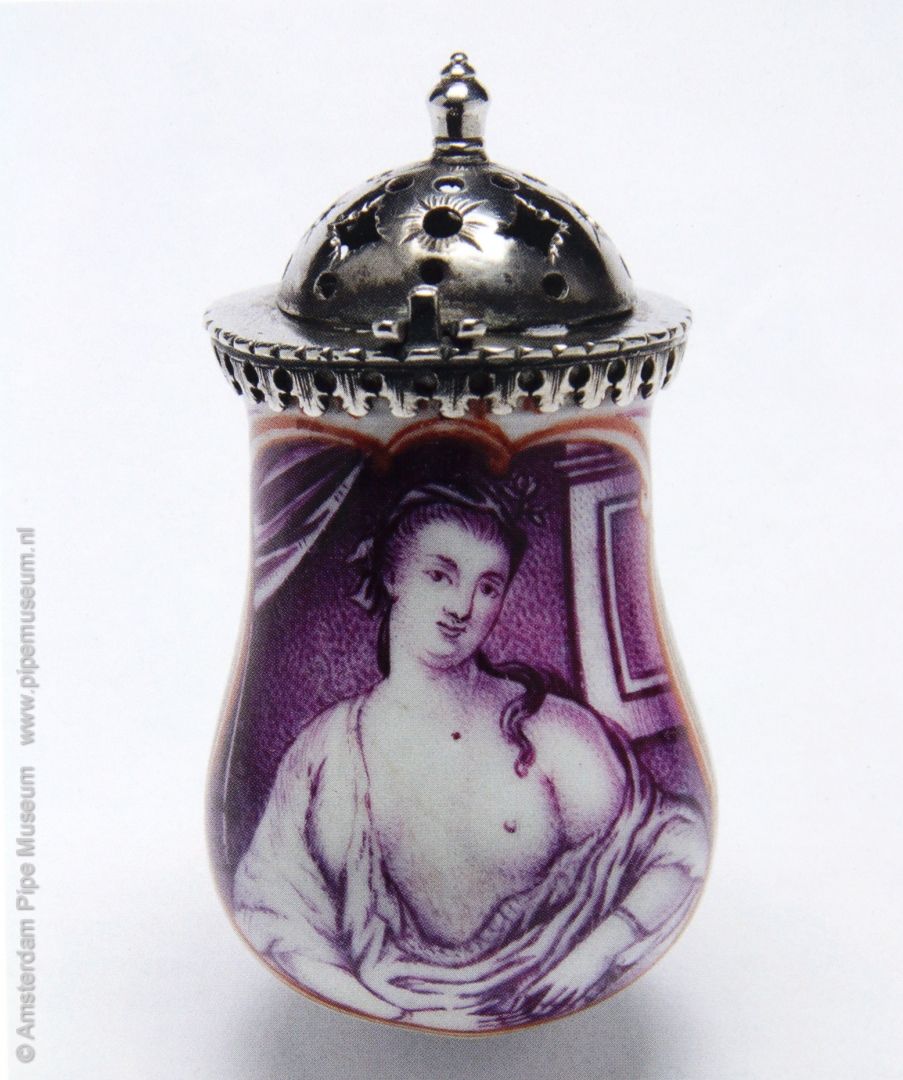
A wonderful highlight is the vulgar depiction of a naked man with a huge neck goitre who is trying to defecate (116, fig. 5). Models devised earlier are regularly produced again in later times, provided with an adapted painting, sometimes also with a change in the modelling. In addition to his own designs, Kändler corrected the work of fellow designers in the factory. For the tobacco pipe, Johann Gottlieb Ehder is the main assistant. The careers of these and other individuals can be followed in the unique surviving Arbeitsberichte, which report accurately on the range of work performed at this factory.
This chapter also provides a comparison with products from other factories that meanwhile started to copy the art of porcelain making. This provides a vision in a broader perspective. The section concludes with a nomenclature of the designs made during that period. They come from the so-called Ältestes Formenbuch, which lists 140 shape names. It can be established that there are no pipes from the first forty years of the factory. Morgenroth appears to be able to link most of the descriptions to pipe bowls that have survived in (museum) collections.
Chapter V (p. 162-214) finally deals with the Meissen pipe production from 1790 under the influence of the so-called health pipe, which refers to the pipe with a moisture bag or moisture trap. It is a pipe bowl of the Holländische Sorte, so based on the Gouda clay pipe with oval bowl, but with a short stem (fig. 6). In that period the factory was headed by Camillo Count Marcolini-Ferretti (1739-1814) since 1774, about the time that Höroldt and Kändler died. Marcolini remains in office until 1814, but is manager rather than artistic director. It is the time of the so-called Sanitätsgeschirr, porcelain whose glaze is no longer lead-containing. Consumers have become significantly more critical of their health and attach importance to the Bleifreie Gesundheitsporzellan. It is the first time that the adverse effect of lead in porcelain has been mentioned in pipe literature.
During that period, the design aspect of the tobacco pipes gradually ebbs away, taken over by the painted decorations. The factory has now grown to about a hundred painters with a palette of 35 colours. The volume of pipe production has increased tenfold compared to the eighteenth century, production is then about 1500 pipe bowls per year. Most paintings are characterized by a silhouette-like contour that contrasts with the white porcelain background (168). The band (all over the bowl) holding the lid that replaces the metal in the pipe bowl is also part of the pursuit of health. Gradually we see the dawning of the period in which the Königliche Porzellan Manufaktur in Berlin begins to dominate. This factory produces approximately one million pipe bowls per year, half of which are sold as white goods to be painted elsewhere. This immense activity quickly puts the Könichlichen Sächsischen Porzellan-Manufaktur in the shade.
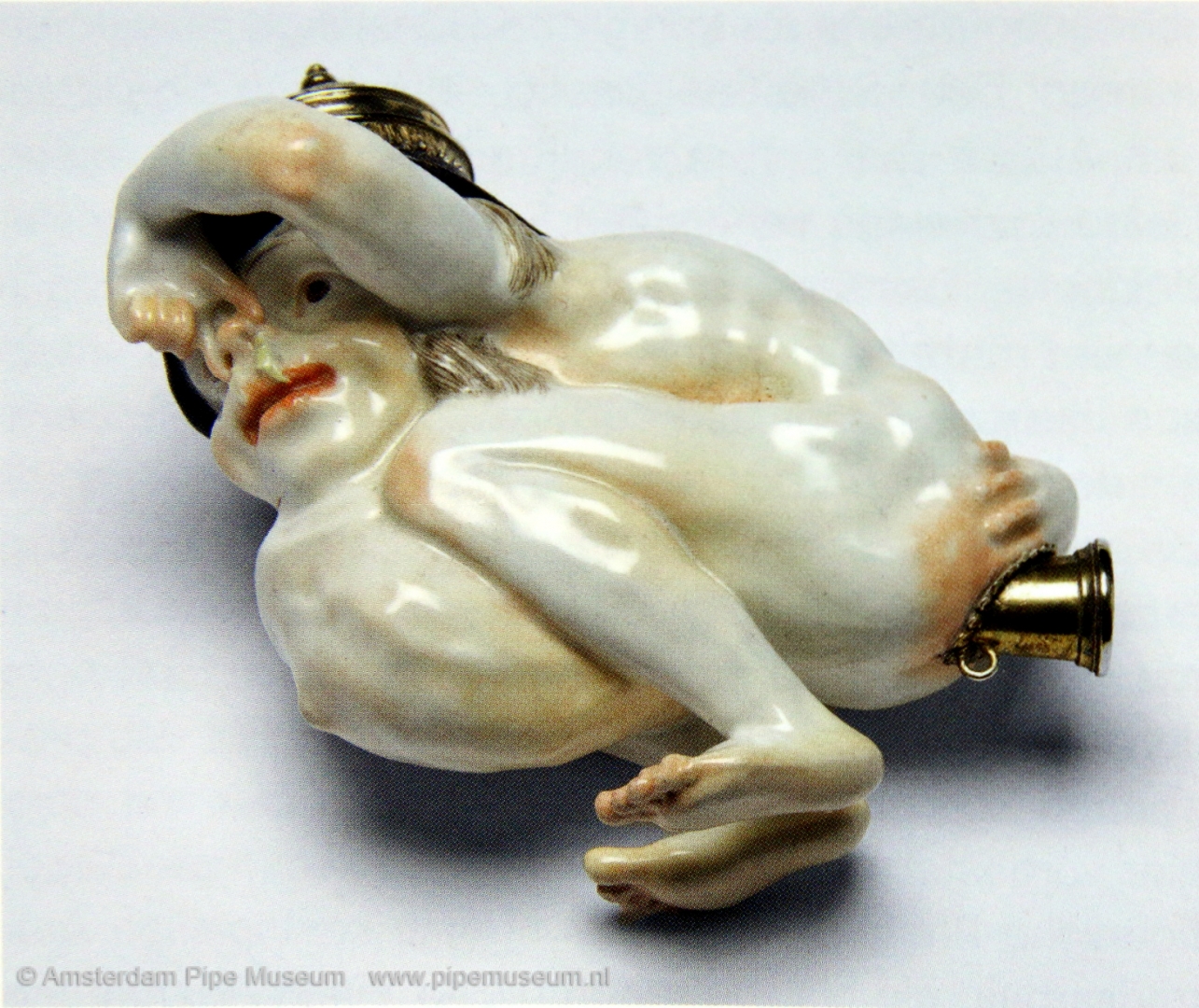
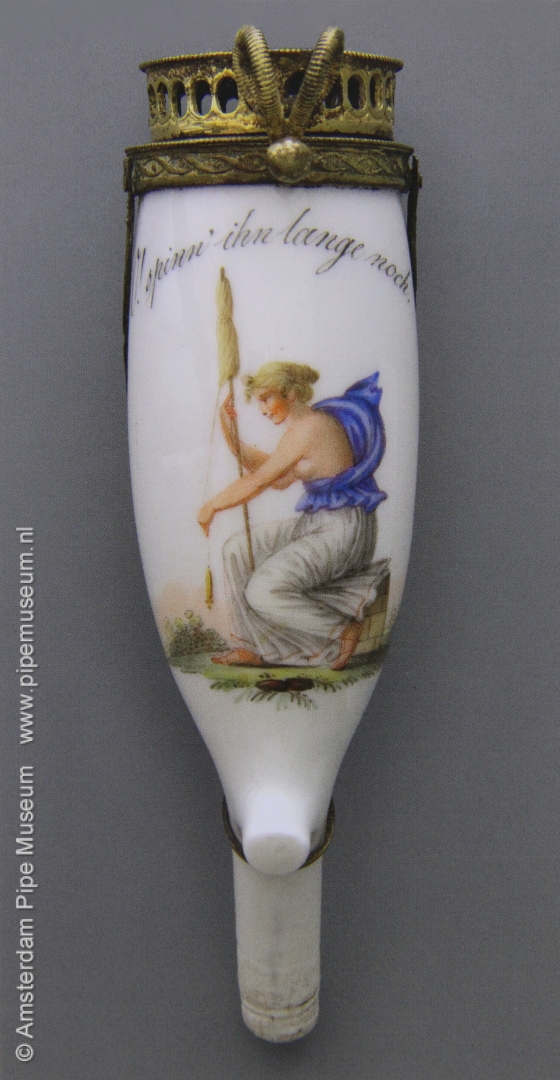
In short, that’s how we can summarize the book. If we compare the new edition with Morgenroth 1989, we see that knowledge has increased tremendously in thirty years. After the first porcelain book, Morgenroth has energetically continued to gather facts to further unravel and understand the German porcelain production. This has led to a great result, in several respects. With the new information, many thoughts have evolved into well-defined knowledge, which in turn has led to new hypotheses and additional conclusions. Thanks to this new work, we are able to understand the history of the porcelain pipe and place it in the general porcelain production of the eighteenth and early nineteenth century. Moreover, it is now related to the big names from the history of the famous Porzellan-Manufaktur of Meissen. The four protagonists are Böttger, Kändler and Höroldt and then Marcolini, who each in their own were decisive in the appearance of the noble product of the royal porcelain factory Meissen. Around these four directors was the countless crew of deserving modellers and skilled painters who actually created the product because they realized the serial production. Inevitably, in the last chapter you sense that Morgenroth loses his interest with the painted Stummel of the post-Napoleonic era. Although the history is beautifully described, the passion for colour and form has faded.
It turned out to be possible to write this book thanks to the unique fact that almost the complete factory archive of the Meissen factory has been preserved. This corporate archive shows unprecedented detail from the date of each new design to the personal background of the staff. It also becomes clear that this leading company has given the impetus to the product development as it has happened, even with the porcelain pipe, a development that is clearly unfolded in this book.
In his argument, which is based on extremely thorough archival research, Morgenroth competently interweaves his versatile knowledge that is relevant to the porcelain tobacco pipe. Sometimes this is linked to developments in technology, such as the properties of shards and the possibilities of the glaze. In other cases, it becomes clear that the product is heavily influenced by the fashion and lifestyle of the target audience. In addition, the author points out the influence of the economy, of tobacco cultivation, the tobacco trade and excise duties. Those different storylines are skilfully intertwined into a mainline and provide a consistent argument that takes you through history. You get to know the main characters in the design and execution of craftsmanship personally and you get to comprehend the complexity of the porcelain as a product to make. The circumstances of manufacturing are often difficult, especially when frustrated by wars, occupations and other unrest in the region where the factory was located. The strongest example is the Seven Years' War (1756-1763), when the factory came to a complete standstill. Industrial espionage is another obstructive factor, in the initial period the buildings are even permanently guarded against espionage by about forty soldiers!
If we look at the illustrations, only a small part was already used in the first publication, however than largely in black and white. This concerns about thirty of the 170 pipes depicted. Particularly new is the dominance of a private collection from Munich that has been built up over the past three decades. This important collection contains an almost complete overview of the early porcelain pipe that was carefully studied and lovingly described by Morgenroth. The present publication shows no less than ninety specimen from that collection. In addition, 25 examples are privately owned. Also not unimportant is the part taken from museum collections, with the city museum in Regensburg and the Amsterdam Pipe Museum dominating with seven copies each. Six pipes from the famous Rothschild collection are depicted. The auction houses also supplied quite a few illustrations. Many of the pipes depicted are of outstanding beauty and some of the designs surpass our boldest expectations. These are highlights in the field of design, depiction and the way of painting, three spearheads of the Könichlichen Sächsischen Porzellan-Manufaktur to achieve the highest quality.
After the pleasure of reading, every critical reviewer looks for areas for improvement. They turn out to be minor. For example, a map with the Bavarian factories would have been helpful for the foreign reader, although it is understandable that Morgenroth himself has no need for it. Scheduling the factories with a timeline of their activity would also have helped to illustrate Meissen's unique leading position in the first phase. Furtheron, it is a pity that countless other pipes that are being discussed in the text are not depicted. As a reader you would love to see them, but apparently that was not within reach. Finally, there is no register for quick reference to persons or subjects.
In summary, the book has the same theme as Morgenroth 1989. The inventory phase of the eighties has now passed, which provided us with the first overview of the porcelain pipe. The structure behind the industry has now been unravelled in detail and the most interesting achievements are presented. That story is convincing and reads like a train. Thanks to the unremitting energy of searching for missing pipe bowls and interpreting them on the basis of the abundant archive material, now after thirty years of ongoing study, a crystal-clear picture has emerged of the development of the porcelain pipe over a period of more than a century. It is not surprising that the Könichlichen Sächsischen Porzellan-Manufaktur sets the tone. At the end of the book, Morgenroth rightly concludes that the porcelain pipe, as a typical German Kulturgut, has conquered a place in the worldwide history of smoking. The Meissen pipe has thus become a cultural-historical document of the Genusskultur (the arts of delight). I would like to add: even of the Hofkultur in view of its exclusive and exquisite character.
© Don Duco, Amsterdam Pipe Museum, 2021
Notes
[1] Walter Morgenroth, Tabakpfeifen Sammeln - Kunstwerke in Porzellan, Laterna Magica, München, 1989, 216 pagina’s. See also: Don Duco, Boekbespreking: Walter Morgenroth, Tabakpfeifen Sammeln - Kunstwerke in Porzellan, München, 1989, Amsterdam, 1990.